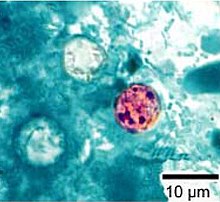Cyclospora cayetanensis
| Cyclospora cayetanensis | |
|---|---|
 |
|
| Cyclospora cayetanensis oocysts | |
| Scientific classification | |
| Domain: | Eukaryota |
| (unranked): | SAR |
| (unranked): | Alveolata |
| Phylum: | Apicomplexa |
| Class: | Conoidasida |
| Subclass: | Coccidiasina |
| Order: | Eucoccidiorida |
| Suborder: | Eimeriorina |
| Family: | Eimeriidae |
| Genus: | Cyclospora |
| Species: | C. cayetanensis |
| Binomial name | |
|
Cyclospora cayetanensis Ortega, Gilman & Sterling, 1994 |
|
Cyclospora cayetanensis is a protozoan that causes disease in humans, and perhaps primates. It has been linked in the United States to fecally contaminated imported produce, and was virtually unknown before about 1990, but has been on the rise since. The health risk associated with the disease is usually confined to adult foreigners visiting regions where the species is endemic and acquiring the infection; consequently, C. cayetanensis is a cause of "traveler's diarrhea".
This species was placed in the Cyclospora genus because of the spherical shape of its sporocysts. The species name refers to the Cayetano Heredia University in Lima, Peru, where early epidemiological and taxonomic work was done.
The first published report of Cyclospora cayetanensis in humans appears to be by Ashford (1979), who found unidentified Isospora-like coccidia in the feces of three individuals in Papua, New Guinea. The photomicrographs in the paper reveal an organism morphologically identical to that we see now. Later, Narango et al. (1989) reported what may be the same organism from several Peruvians with chronic diarrhea and termed the organism Cryptosporidium muris-like. Other investigators thought the unsporulated oocysts appeared more similar to cyanobacteria, and the name "cyanobacterium-like body" or CLB became prevalent in the literature (occasionally, authors also used the term "coccidian-like body", or CLB). Eventually, Ortega et al. (1992) published an abstract reporting that they had sporulated and excysted the oocysts, resulting in placement of the parasite in the genus Cyclospora. They also created the name Cyclospora cayetanensis at this time. However, since no morphologic information was presented in the abstract, C. cayetanensis technically became a nomen nudum (a named species without a description). Although Ortega et al. (1993) later published additional details about this coccidian, it wasn't until 1994 that a complete morphologic description was published to validate the name (Ortega et al., 1994). Thus, the correct name for this parasite is Cyclospora cayetanensis Ortega, Gilman, & Sterling, 1994, and the etymology of the nomen triviale is derived from Cayetano Heredia University in Lima, Peru. During this 2-year period when C. cayetanensis was a nomen nudum, anyone wishing to publish a complete morphologic description and change the name would have been free to do so.
...
Wikipedia
